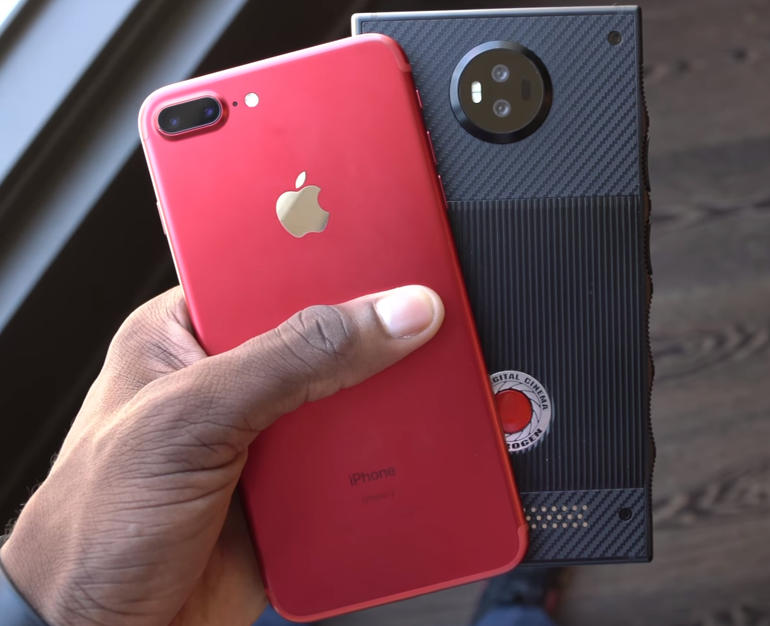

RED’s Hydrogen One is slim but tall and wide, easily dwarfing the iPhone 7 Plus.
Image: Marques Brownlee/YouTube
High-end cinema camera maker Red has been teasing its forthcoming holographic smartphone for the past month, and has now offered the first full view of its prototypes.
RED’s cameras have been used to shoot hundreds of films since 2005, such as Guardians of the Galaxy 2, and most Netflix hit TV series including Stranger Things season two. Earlier this week it struck a deal with Apple to sell some of its high-end kit exclusively at apple.com.
But in early 2018, RED may be competing with Apple — amid its push into augmented reality (AR) on iOS — with the 5.5-inch holographic display Android-powered Hydrogen One smartphone.
It won’t be cheap. The unlocked phone will cost a whopping $1,595 when pre-ordered for the titanium model or $1,195 for the aluminum variant. RED founder Jim Jannard has suggested it will be more expensive if and when it is released.
But for that price, it’s promising a phone that can deliver a holographic view or ‘4-View’ without a wearable display and “multidimensional audio” powered by its H3O algorithm.
The device will also offer modular attachments for shooting video, stills, and holographic content. The phone also integrates with its cinema cameras as a user interface and monitor.
That approach would dovetail with REDs modular camera business, which offers the $49,500 Weapon 6K camera without a screen or other essentials.
On Wednesday, YouTube star Marques Brownlee published his hands-on with three prototypes showcasing the full design without a functioning display or camera, the body with an attached RED camera sensor, and a third prototype with a functioning holographic display.
The Hydrogen One has an industrial hard-edge design with finger grips along the side, presumably for more secure handling when loaded up with modular attachments.
The phone is slim but tall and wide, easily out-sizing the iPhone 7 Plus, with a top and bottom Kevlar panel and a metal mid-panel featuring a large red dot embossed with ‘RED Digital Cinema’.
The power button on the right-hand side will double as a fingerprint reader while on the left are separated volume buttons embedded in two ridges. There’s also a dedicated video record button on the right-hand bottom.
The prototype design has a USB Type-C port on the bottom alongside a headphone jack that is due to move to the top on the final build. The lower rear features a high-speed data bus to support attachments. The front lower bezel space houses dual speakers and additional speaker on the top bezel between two sensors.
The design prototype didn’t have a working display or camera module. RED only allowed Brownlee to show his reaction to the prototype with a working holographic display. He said he was “pretty impressed” with the holographic view.
According to Brownlee, within the next 45 days RED will have a working prototype with the fit and finish, and the holographic display in the same body.
ZDNet sister site CNET has dug up several camera-module patents that offer promising signs that RED’s claims are achievable. The patents are also consistent with RED’s success in selling high-end modular digital cameras.
REDs Jannard has offered a few additional details on the company’s user forum. The built-in camera won’t deliver cinema-quality images, which is where the modular system comes in to add “image quality well beyond any other camera short of our professional cameras”.
Attachments will also be required to create 4-View holographic content, according to Jannard.
The phone won’t have a lenticular display like Amazon’s 3D Fire Phone or LG Optimus, but rather “technology you haven’t seen before”.

